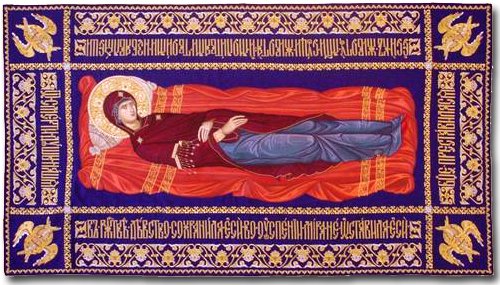 During this coming week, our Church will celebrate one of the six major feasts of our Church that honor the Mother of God. It is her Dormition or her falling asleep. This is the last major feast of the Church Year. This feast celebrates the fact that her body did not know corruption after death but, together with her soul, was taken up into heaven.
During this coming week, our Church will celebrate one of the six major feasts of our Church that honor the Mother of God. It is her Dormition or her falling asleep. This is the last major feast of the Church Year. This feast celebrates the fact that her body did not know corruption after death but, together with her soul, was taken up into heaven.
The earliest written tradition which speaks of the death of the Mother of God, is found, in the East in the document known as the sermon of St. John the Theologian on the Dormition of Mary. The author is unknown. Some historians believe that this work dates from the end of the second or third century, while others place it at the end of the sixth century.
From the beginning of the sixth century, it was believed that the Church on Mt. Sion is the site of her dormition. It cannot, however, be proved.
Some historians believe that she died in Jerusalem while others claim that she died in Ephesus where St. John was believed to have taken her at the death of Jesus. Even today a house in Ephesus is pointed out as the one where the Mother of God allegedly lived.
The liturgical cult of the Mother of God began with the Council of Ephesus (431), which defined the dogma of her Divine Motherhood.
None of the Fathers of the Church mention her dormition prior to the fourth century. It is not until after the fourth century that, on the basis of tradition, Church writers began to write about the final moments of the life of Mary, the Mother of God. These include Gregory of Tours (+594) in the West and the Patriarch of Jerusalem, Modest (+634), who was the first to have a sermon on this event, and St. Andrew of Crete (+712) and St. John Damascene (+749) in the East.
Toward the end of the seventh century, and at the beginning of the eighth century, church writers began to direct their attention not only to Mary’s wonderful dormition, but also to her ascension into heaven body and soul. The most interesting and most substantial testimony on the Dormition is given by John Damascene.
Again, as the Church thought about the events in the Lord’s life, Who truly represent male human beings, they had to observe parallel events in the life of Mary who truly represent female human beings. There are parallel feasts for the Jesus and the Mother of God. Monday, August 15th, is the feast.
